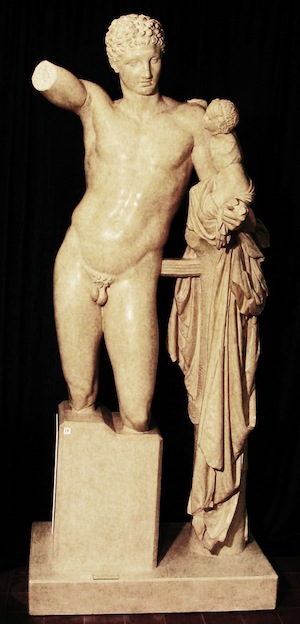Classical Greek Sculpture
Hermes with the Infant Dionysus
Classical Greek

date of the original: mid-4th century BC
provenance of the original: discovered in AD 1877 in the cella of Heraeum, Olympia; now in the Olympia Museum, Greece
description:Male figure with legs missing from just below the knees. Right arm missing above elbow. Small, childlike figure sits on left arm. Draped trunk for support. Punch/chisel marks on the back. May be a copy of a Praxitelean original. Plaster replica; Parian marble original. Height 215 cm, width 100 cm, depth 70 cm.
This sculpture is the work of Praxiteles of Athens (c. 390-332). He seems to have been the most highly regarded sculptor in antiquity. Considered to be a “sensual” artist, Praxiteles is said to have represented with refinement the feminine body and the body of theephebe, the somewhat effeminate young man. Praxiteles was not what one could call a sculptor of gods and heroes; his work reflects the secular, worldly trend of the Late Classical epoch. (See also: Aphrodite of Cnidos; Aphrodite of Arles; Apollo Lykeios.)
Though this sculpture was found at Olympia and was certainly commissioned for that sanctuary, it is worldly in concept and effect. The Classical restraint and poise is replaced by an undulating body in a defined S-curve which defies equilibrium. While the proportions of the infant Dionysus are not quite lifelike, the inclusion of babies/children in Late Classical sculpture is significant of social changes, of the prevailing secularism and sentimentalism from this point on. (See: Child and Goose.)
The present cast was made from an unfinished statue, as is apparent from the back, which shows still unpolished traces of tools. This suggests to some that the copy in this collection is a copy of a copy, since the original would not have been unfinished. This is not necessarily logical, but much hair-splitting characterizes the discussion of such problems. In any case, it is interesting to see unfinished works as they help us to learn about ancient techniques.
Hermes, equivalent to the Roman god Mercury, was a messenger to the gods and a trickster. He is often depicted in Classical art with the herald’s wand, winged hat and boots (or sandals). Dionysus is a god associated with emotion. His devotees, mostly women, were often seized by an ecstatic state, and abandoned their homes and families to wander and dance in the mountains. At the height of their frenzy they were known to tear apart animals and devour them. (See:Maenad Rending Her Prey.) Dionysus’ Roman equivalent is Bacchus.